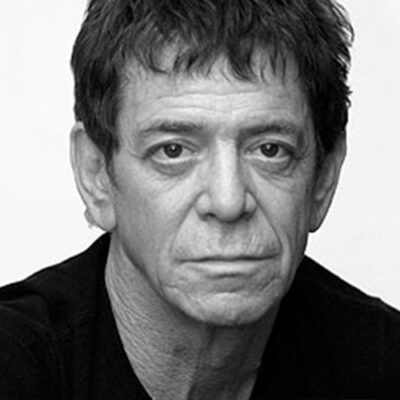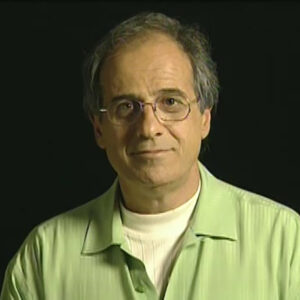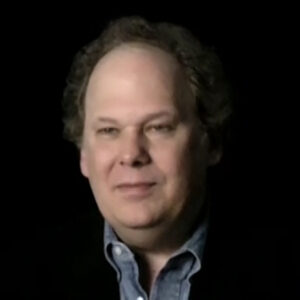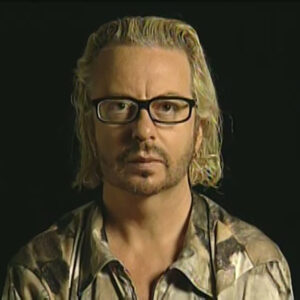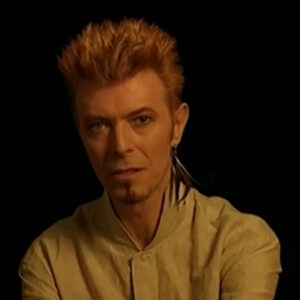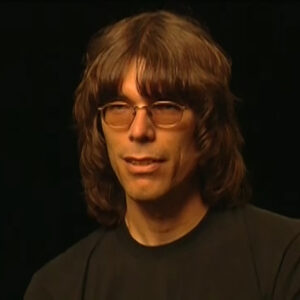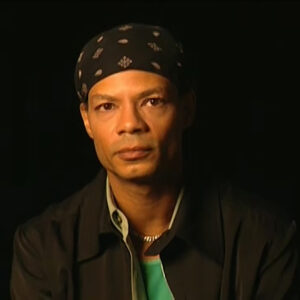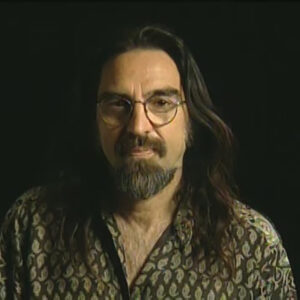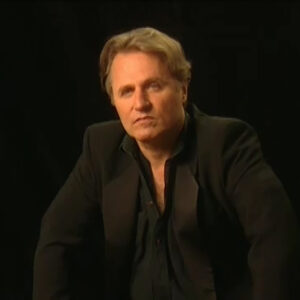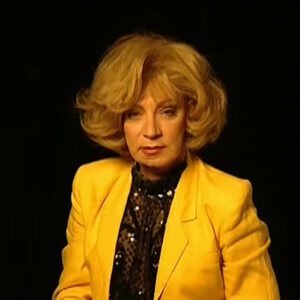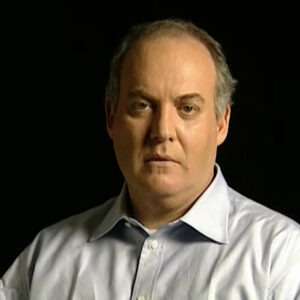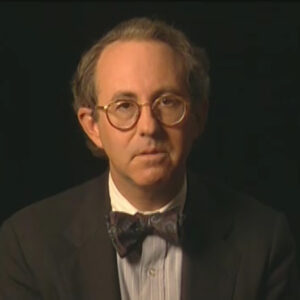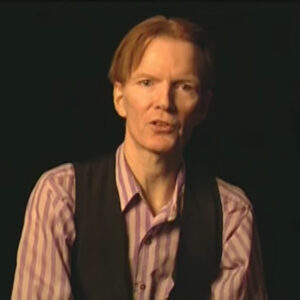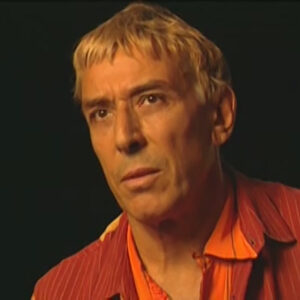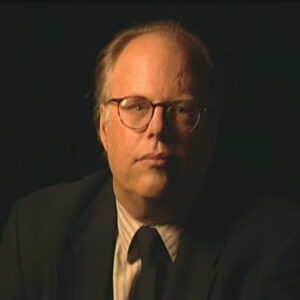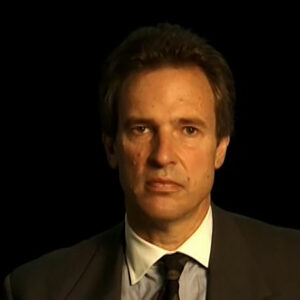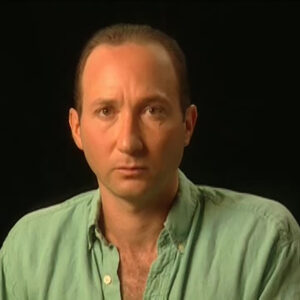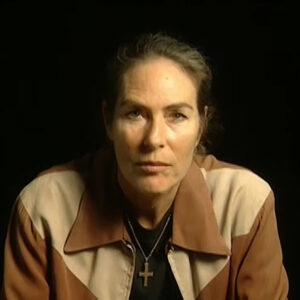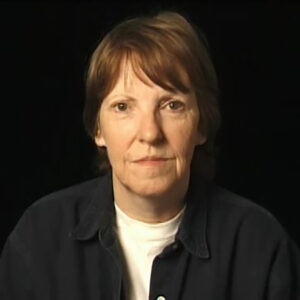Speaker The Silver Factory was a large space that Andy had gotten. He had been painting at New York City owned firehouse, which I guess he had to leave because it was condemned or something. So he got this large space on its 47 street between second and third. And he had been at my apartment to one of my hair cutting salon parties, Ray Johnson, Vernon Decolletage, artists. And I had covered my entire apartment with silver foil and painted everything silver. Even the silverware was painted silver. So Andy just was struck by the great beauty of it. And I had theater lights all over. And because we knew each other from years before he spoke to me, to me immediately as a friend, I said, Oh, Billy, I just got a great new loft space uptown. Would you do to it what you’ve done to your apartment, which for me was like an installation. It was an insulation piece.
Speaker So I took the dishwasher to the kitchen and tried to dishwasher, replace Rod. That’s exactly what I was hoping. Okay, so you can just pick up where you were. Yeah. This is with.
Speaker We can wash dishes and.
Speaker So we’re going we’re going to wait for Tony or not?
Speaker I think so, yes.
Speaker Have county.
Speaker Go ahead. OK. So we were rolling.
Speaker So Andy and I already having known each other, we synchronize easily, and he invited me to come up and do a silver installation at his new launch phase. This was. Late 63 and early 64 in 1964.
Speaker And you were then. How were you a member of this sort of factory at that point that you became a photographer right now?
Speaker Tell us how well this was at the time when Andy started to make films and he had been using a 35 millimeter SLR, Honeywell, Pentax. And at one point he just handed it to me and said barely. Here you start doing still photography. I’m going to make movies. He had just bought the black 16 millimeter silent camera. And because I had been a theater lighting designer and set designer, I was almost exactly what he needed at that time because he started we started doing the so-called art films in the factory. They still do. Still lives. And the portrait screen test. And so I did very simple and very, very dramatic lights and set for it. So I had the skills that he needed to complement what he was starting to do.
Speaker Before we go into your photography, tell me a little bit about the process of a screen test.
Speaker Well, the process of a screen test for Andy was a cat cameo camp on the Hollywood screen test mode because Andy really loved Hollywood films and the whole kitsch of the filmmaking situation in Hollywood. And in a sense, it’s like an artistic joke, his take offs on Hollywood. So whenever people would come over to the factory and many people did, especially as he started to become famous, he would say, oh, could could we could we do your screen test? And it made people feel so wonderful that they were going to have their screen test because it was actually his way of continuing his portrait. You’re no longer on canvas, but now on film. And Andy, I think, was really the greatest. As a portrait artist. And so I would do a very simple setup like this with a black flat or black or white photo paper or simply a silver painted big piece of plywood. Use a single light coming from one angle. This is that great 60s look, you know, and we would shoot in high contrast, try X fast film person would be set in place and he would focus the cameras, set the F stop and focus it, and then he would turn the camera on and we would all walk away and the person would be sitting there having the screen test done.
Speaker And most people were almost petrified. They would just sit there and not being told what to do or directed. They would be so petrified tears would roll down their eyes afterward. You know, when the film ended, we would come back and they would say, But you didn’t tell me anything or what to do.
Speaker And we said, well, it was your screen test. We wanted to see what you would do or what you are. But Andy didn’t direct verbally. You know, it was it was traumatic for other people, but it was a great joy for other people, like his great stars, Undine or Bridgie, Berlin and even E.T. Sedgwick, who is so poised that she naturally took over as her space.
Speaker If they said, can you talk a little bit about that sort of high contrast, Lou? Talk to me about how he fell in love with this sort of high contrast. Photography ability. What is that? The lighting situation. What was it?
Speaker Well, the photography of Billy name in the 60s is now a genre, Ashley. A number of photographers have used it. It’s called 60s photography. And it mostly came about because of Kodak’s new film, Triumph’s, which was a 400 speed fast film where you could work with available light. You didn’t need an enormous studio setups. And all of the French cinema verité artists were doing the outdoor hand-held scenes with with the grainy lock and simply because it was a fast speed film. And that’s how it came out when you developed it. So Andy was using it for his early for his early silent movies. And I used it for the stills. And I almost immediately I started developing my own film so I would overdevelop it. Sometimes I really like the the intense the graininess was a characteristic of the film, but I liked the really high contrast, the intense black and white chiaroscuro look. And other photographers in the 60s used that look, too. And it was possible because of the film and because of sun guns, because because we had new new equipment, new tools or new toys, as Andy would say.
Speaker Can you talk about when the velvet’s?
Speaker I don’t know if you were there when Andy went down to the cafe, bizarre in that development, but certainly after that they came and started to hang out at the factory. Can you talk about what you remember of that?
Speaker Yeah, I remember when we first got to space. I think we were gonna do a multimedia show and we wanted to have a rock group. And it was also for our college tours. We wanted to have a rock group to make a multimedia show. So I believe it was Barbara Rubin and Gerard Malanga who took Andy and Paul right down to the cafe, bizarre and and discovered the Velvet Underground. I wasn’t there at that time. But then like the next day when they came up to the factory and everybody decided they were gonna be our group. I realized that John Cale was one of the members and and I immediately went over it to an audience and said, Andy, if John Cale is part of this group, you need have no question. But it’s going to be very special and very great, because I knew John when I had worked with Lamont Young drowning with Lamont and his hours and days and months long music pieces. And I hadn’t met Lou or Sterling or Maureen Multi-color. Now as the percussionist. But I knew the original percussionist Angus McLeese, too, from the mine. So when they came up and I saw John. I was immediately struck and said, wow, you know how worlds interlink and how how you recycle with each other. Because John is a genius. You know, as Lou says, John is the Beethoven of Rock Me.
Speaker So John is the Beethoven of rock music. What is.
Speaker What is there? I think he’s the Mickey Mouse. Or anyway. Andy wanted him to be, you know, as Walt Disney had Mickey Mouse. Andy Warhol wanted Lou Reed. And in a sense, they’re similar characters because Lou is a very typical American guy in New York kind of guy, but a very guy, American guy. And he has that naughtiness in him, because if you if you know anything about Walt Disney, Mickey Mouse, Mickey Mouse originally and in what was a captain, something anyway, the first Mickey Mouse cartoon, Mickey was evil and nasty and a mean guy. So so in a sense, Lou can be that, too. But. In his purest nature, he’s just everybody’s friend and buddy and lovable guy. So if the if Eric Emmerson hadn’t brought a lawsuit to get money for the back of the first album, The Velvet Underground and Nico, the Banana album, and made MGM pull it off the racks and out of the stores and off of the air, because it had just gotten into the top 50 charts and was moving up. But because MGM pulled it, the group didn’t it couldn’t be reintroduced or it couldn’t be re premiered. So it fell off the chart after the LA thing was settled. And that sort of killed the momentum of the Velvet Underground becoming something like the Mamas and the Papas or the Mothers of Invention, which they would have been right in that class if that first album had moved up. But unfortunately for the litigation, MGM freaked and just pull it, pulled it off the air. So the momentum for the Velvets becoming like a Mickey, you know, was broken. So this is when the relationship between Andy and Louis started to deteriorate because there was no economic return. No, for all the work we were putting in. It didn’t appear like it was just going to fly, as it would have if it if it weren’t interrupted. So he didn’t become Andy’s. He became Lou Reed and and very forcefully so. I think Lou really takes pride in being Lou Reed. He’s such a special character and a well-developed type of guy that I think he really is glad that the breakup happened, that he was forced to go out and make it on his own because that’s what he always wanted anyway. He’s that kind of star, that kind of guy, you know.
Speaker That was great. Can you tell me what the friendship of a and he was like in the beginning? I think it was a struggle between the two of them than the rest of.
Speaker I think so, too, because. Oh, yeah. Well well, Lou and Andy had a very magic relationship in the beginning. Their roles were both very special people and starlight people. And look out of that whole scene, the whole factory scene. Andy Warhol and Lou, Ruth, Lou Reed are the most well-known people, you know. I mean, worldwide. So they had a magic relationship, just like when two talented people are geniuses, get together and realize they can play together and create things together and make things together. And, boy, what a wonderful time we have. It’s great to work with peers. You know, you’re your genius plane. And so for, you know, maybe the first six months, the first year, there was just that magic special thing going on where they knew wonderful things would happen because the contents, the ingredients were also perfectly synchronized and match and there was so much love and play in it.
Speaker But then when the album got pulled, everything it really is economics that destroys these joyous things. And when it looked like they weren’t going to make it big, Andy had other things he wanted to do and Lou didn’t want to be and try to make it big. They wanted to be, Lou. Andy wanted to go on to his other filmmaking. So that was the crux that broke it. Can you?
Speaker Toga Lou, talk this morning about how he was not so much. A producer. He was just there to take all the flack. Well, the Velvets were allowed to kind of do what they want to do. Is that the way you.
Speaker Well, in terms of Andy Warhol as the producer of the Velvet Underground and their album, I think Andy really was the producer. And in a sense, where he could take the flag while they could be the the artist, so to speak, and do their music. There were really a number of other people who work for and with Andy who were the buffer’s. Andy was really the front. And the name under which everything went out. But I and Paul Morrissey and Gerard Malanga and Fred Hughes, we were the ones who would redirect the flack into his various channels where it was supposed to be said, because Andy was a very vulnerable person.
Speaker He was very shy, very physically sensitive and could be easily hurt. So all those of us who loved him and loved to work with him knew what roles we naturally played in protecting him so that we could all continue to have this wonderful creative scene that the factory was.
Speaker So when the Velvets arrived at the factory, what was a typical day practicing there? Tell us what was going on there.
Speaker Well, the Velvets arrived at the time when Edie Sedgwick was still our big star. Jane Halter had been the first girl of the year Warhol film star, and now Edie Sedgwick was the new girl of the year. And it was very glamorous and would be photographed by Life magazine. And the papers would cover Andy and E.T. going out to art events. And E.T. dyed her hair silver to magic hands. So it was the 80s Sedgwick period in the factory where everything was silver. It was our film star.
Speaker And she was absolutely loved and adored by everyone. She was such a beautiful, poised angel. A great director is a great performer. When he walked into a room. Everyone was on point because they knew something excellent had all of a sudden happen in their space. So she was very special on the factory, was being very special at that time when the Velvets moved in to become our group.
Speaker And actually, it’s because Edie walked out on us and went with Dylan, Bob Dylan and Grossman. You know, she wasn’t happy about the films. She wanted scripts or Andy wouldn’t use scripts or she wanted to act or Andy knew she wouldn’t act if he wanted to. So there was this whole blow up in 80, dropped us and went with Bob Dylan. And Grossman was supposed to be her manager. So we were scheduled to do in 80s Sedgwick Film Festival at the film Jonas Megadoses, filmmaker, Cinematheque. And what we ended up doing instead because E.T. dropped us was making a film called The Velvet Underground of the Velvet Underground playing in the factory.
Speaker And what we did, instead of an E.T. centric film festival, was the first uptight program. Andy Warhol uptight the Velvet Underground performing on stage with your art milonga and marijuana of an 80s and angered superstar dancing and marijuana off and on. Then we would project the film we had made of them at the factory. So it was like Velvet Underground on Velvet Underground while performing alive. And then we would make. And in addition, we would when we would do the college tours, we would do the film on the live performance, but film that whole event. So everyone who was part of the live performance and attending as dancers or whatever to see the show, they were in the next version of Andy Warhol, uptight. So it was film on film in film.
Speaker Any recollections of the psychiatrist?
Speaker Well, the psychiatrist convention was sort of odd because it was I think after the time that Andy had stopped not doing the college tour circuit, not doing it because Alan Midgard did it for him, because the first few times when we realized you could get a couple thousand dollars by doing a college tour presentation and he started to do it and Paul would go and Gerard and whoever else was in the films. But Andy never talked. You know, he was told so, so shy. And Paul would usually do all of the talking. He usually does. Yeah. He’s great talker. And at a certain point, Andy said, well, he didn’t want to go anymore because he had wanted to do the painting at the factory. He wanted to work. He was a workaholic. He didn’t like spending all that time away from the factory, not being able to work. So we decided we would send our leading male star at the time, Alan Magette, as Andy on the college tours. So we silvered his hair and made him up and and did several different colleges before someone at one college out West who had met Andy knew it wasn’t Andy. And Time magazine ran this thing on. The experts say most of the colleges that we did go to didn’t demand their money back because they all thought it was a perfect Warhol event.
Speaker And I think two of them wanted their money back. Two out of 12, maybe. So now, now we could do. The tours. Well, you know, just cut that when they’re in and out.
Speaker Can you tell me, Nico?
Speaker Nico, it’s people like yeah, people always ask me about Nico and new, particularly as to whether or not they had an affair. And some people tell me they had. But I don’t know, because I was always living in the factory. Everybody else had their own loft of their own apartment. So they did this thing, these things clandestinely in their various apartments and loft. And I don’t know. But people tell me they did. And also that John and Nico had an affair. But I know Erica Emerson and Nico had an affair. But Nico is just a hauntingly beautiful, beautiful woman. And the first I heard of her, we were at the factory one afternoon and Gerard had just come back from Europe.
Speaker With a little 45 r.p.m. record and drought came in just walking in and his his genuine waiting. Hi, everybody, I, I just got back from Europe. I have to. I have this little record. I want you to hear of this friend of mine, Nico, who I just met, and she’ll be coming over to New York soon. So.
Speaker So she he played the record and it was a Dylan song, I guess, that Dylan had written for Nico. I don’t remember exactly which one it was. I’ll be your mirror one of those. Now, that’s a love song.
Speaker What’s the difference? My.
Speaker I’ll make few. I’ll keep it with mine. I’ll keep it with mine. Yeah. That was the deal anyway. So then Nico did come over and after having seen the film, Nico Icon explained in there that she was recommended to go to New York to work and Warhol films because she wasn’t getting any particular film work over there. And so she actually came to New York to meet this filmmaker. And it’s bills which, you know, to me in retrospect, is such a riot because we were that. But we didn’t really seem to be that, even though that’s where in actuality we were we were leading filmmakers and at the time. So Nico came over to be in films, but he was an interesting Shantou. Also, Paul Morrissey sort of felt that Lew wouldn’t be a big enough of attraction as the lead singer to attract lots of people. He said, you got it. You got to have a beautiful girl in the group.
Speaker So he was trying to get Lew to say and John to say that they would take Nico in as part of the group. And so finally, it wasn’t until Paul convinced Andy or convinced or would do what the more cruel term forced Andy into believing that the group needed Nico. So Nico said, oh, well, they wanted to just do it and let’s see how it’ll work, you know? So they developed really didn’t want to do this because they were the Velvet Underground. They had worked for what they were going to be and what they did anyway. And then the album came out and it really worked well in a very mysterious way because that first album and Nico singing with him is so haunting and it’s really such a strange mix, but it really works well. And then in those subsequent albums, they were just the Velvet Underground, like a white light, white heat and then the Velvet Underground. I did. Lou asked me to do the album covers for the second album, White Light. White Heat. And he I said, well, why why don’t you? Because I guess we were busy or something. I said, What did you look through my contacts and see if there’s anything I’ve already done that you would like to use. And he picked out a shot of one of Andy’s films called Byck Boy. The actor starred in it was Joe Spencer. And it’s a scene where he’s in a room with another one of the actresses. And on his arm is a tattoo of a skull and crossbones, Lou. Just like spotted it and just saw the tattoo on his arm, said Billy. That’s what I want on the cover, you know. So I had to do enormous. I had put my larger head up to the ceiling to get, you know, just an eight by 10 of the skull and crossbones on the guy’s upper arm. But we did do it. It was really very grainy, but we did it black on black on the album cover. So that was Lou’s choice. So that was the first cover I did for them. Then the second one, we had moved to the second factory on Union Square and it came to be called just the Velvet Underground album. And they’re sitting on the sofa with live with the magazine. And I actually did shoot that in Nugget Color negative. It was on the album cover as a black and white print because I didn’t have a color in larger at the time to do color printing. So we just did in black and white. But now I have a book that came out just now with the actual color friends in it.
Speaker Were they just sitting around?
Speaker Well, I did three different setups, you know, saying, well, something will come out of one of them. And one of them, I had them sit again or lean against the wall and then slide down to the floor just like they were puppets. And I would catch them at different points while they were sliding down. Then another one, I had them sitting in the group on the sofa. And in the third said I did a bunch of headshots. So the one on the sofa turned out to be the one we used.
Speaker Now we see it in color.
Speaker Well, I want to mention when Lou said about my black and white look in his songs, too. Yeah, I think we should talk about that. Well, the black and white look from my 60s photography, I think of in terms of Lou’s songs also because there’s there’s a scrunchie ness about them or scrappiness about them, but they’re still so. Natural, that they’re elegant. They’re really unpretentious and just playfully, naturally elegant. And in that simple black and white like loose songs are mostly in what you might call black humor. You know, he’s he has it all black humor sensibility about him from the time when he would always wear the black leather jacket in the 60s and the dark shade.
Speaker So I think that film noir or photography noir or lyrics noir. Are are compatible. They get along and Louise, Lou and I, when we first met, we just hit it off like that as if we had grown up together as kids on the same street. Went to the same school all through our school year. I guess our backgrounds were similar in that we matched immediately, knew we recognized each other in each other because we came from the same background or about the same age.
Speaker So I think in that sense, the artistic production, whether it’s foot photography or the songs in the lyrics, has that same element of wanting to be the black magic artist, you know.
Speaker Can you talk a bit about Maxus? What they’ve just been charged is here. Talk about Max. It seems like you go there.
Speaker Oh, yeah. Max, this was actually Max’s Kansas City, was the fact. Well, the back room was Andy’s room, and upstairs was like development room in those and.
Speaker It was over here just.
Speaker Max’s Kansas City was our scene. The back room was completely and his room. Upstairs where the music was played was the velvet room and those room. And it was almost like our recreation room or our playroom. Like when we go down in the basement of your house and you had your rec room there. That’s when the access was right to us.
Speaker It was almost just across the street from the second factory. So we would just stroll across the street and go and eat and sign for our checks because Andy would give me Mickey Raschein paintings in exchange for letting us sign for our food, you know. And then the Velvets perform there, too. So Lou just took it over as his saying it was our scene.
Speaker And so the people just named a lot of names. Who was there?
Speaker Well, it depends on what section you were. And, you know, if you were in the front room in the bar, you would see all the macho painters and sculptors, John Chamberlain and and the whole macho New York school in Andy’s room was all the. Wannabe’s Hangers-On is an freak’s who knew they could get into Warhol films if they did really wild things.
Speaker Upstairs was sort of a cool mix of the cool set and, well, everybody from the backroom or the front room would go upstairs when the music started playing because you could dance up there. And I remember seeing Bob Rauschenberg just going up and down the stairs as he felt like I’d gotten dance and then come back down and hang around with the guys at the bar. And John Chamberlain and Ultraviolet. It was it was sort of the upstairs was where everybody could just float up and mix because you could dance. You didn’t have to converse, you know, conversation or the lack of it or the intentional non conversation had specific locations in Max’s just like in the factory. Different people would locate at different sections of the factory where the painting was or where the filmmaking was or where the video taping was or where we were transcribing novels. There were lots of sections of every place we seemed to go. Then even in the over on New York Manhattan culture, there were a strata that interacted with each other at various times, like through all the early 60s. John Cage set the pace of the philosophy, the mentality of creation and there in the tone of it. But not everybody interacted with John Cage. I did because I was with people from Black Mountain in the earlier years. But then when I started to work with Andy, the only time I saw John Cage, we were in an elevator with John Cage at one of his concerts. And I noticed that Andy and John Cage were discussing Eric Sarti and minimalism. And so you can see how Andy’s minimalism fit in with John Cage’s minimalism and. It was the tone at the time.
Speaker Songs for Drella.
Speaker Oh, yo. Songs for Drella, I think is a masterpiece. It’s a little mini opera. And it is as good as a Brecht vile opera. I think John Kerry knew he did a magic, magic, creative act there. And I only regret that the Warhol Foundation was so uptight at the time that they didn’t let them use the name Andy Warhol because it was supposed to be called Requiem for Andy Warhol. And when the foundation didn’t think they should use that name in the title and said Lou and John picked up the old nickname we had for Andy, which is a combination of Cinderella and Drek, Dracula and Cinderella, which was Drella, his sort of we would tease him with that nickname. So it became songs for Drella. It’s a masterpiece. And I only regret that more people haven’t seen the Warner video of it that is out. And it’s just magic. Magic moments in particular.
Speaker Songs that you think really.
Speaker I think it’s a comprehensive opera and. Well, yeah. John singing The trouble with a Trump with an impressionist. It’s just crazy. You know, they’re crazy songs. And Lou, with his little turnabouts of. It’s Andy singing. It’s nobody’s like you. It’s just had so many wry but clever but beautiful but tragic, dramatic and sad and wonderful moments in it. It’s a true, true requiem for Andy the moment. Oh, it’s the 24th. Like the first time somebody asked you for your autograph, you know, which haven’t for me. It happened in Paris when the Cardiac Foundation was doing the Walk Home Momar retrospective. And Lou and John were invited over to do selections from songs for Drella. And so I was walking up there, their estate lawn up to where the platform stage was. Someone came running over with a Velvet Underground album cover asking me to sign it. So then I heard myself in the lyrics and selling it for joy. You realize that you’ve achieved a certain plateau or level in your own culture. And when someone finally played me in a movie, for instance, and I shot Andy Warhol, I said, my God, now I’m being portrayed in a film. It’s again, like the first time someone asked you for your autograph. That’s when you’re in lyrics. That’s when someone plays you in a movie. And it’s the thrilling moments. I felt very proud that Lou included me in the lyrics. And after the first performance in Brooklyn Heights, Lou asked me if what I felt about having been in the lyrics. And I said, well, Lou, I can only say that I feel very proud about it and I’m delighted that you did it. And Lou said in his sensible way, glad. That’s what I wanted to hear. I’m glad.
Speaker Can you repeat the.
Speaker Yeah, it was the first time John and Lou now were performing together because of the songs for Drella album, and they had agreed to do something together for Andy. And so it was a tribute to Andy. And at the performance at the Khady, a estate outside of Paris, Mo Tucker, was also there in Sterling.
Speaker Morrison was there, but it was supposed to be just Lou and John doing selections from songs for Drella, which they did, and everybody. Gerarda was a wonderful, wonderful performance. So then after they finished the selections, they said and by the way, everybody, Moe Tucker is here. And I wanted to come up on stage and they did have a guitar set for her.
Speaker So she came up, whether they had a guitar also. She yes, she does drums, too, but she plays guitar now, too, also. And they actually had two guitars. So there was one for Sterling too.
Speaker But they did do heroin. They just like jumped into it. And it was exactly like years before it was perfect. It was so, so, so authentic again and so much the Velvet Underground that people were just tears were running out of their eyes and everybody went nuts. And most daughter was there crying her head off because she had never seen the Velvet Underground play live in her life. And that’s when they started getting to talk to each other again and work together again. And they did the European tour. It was a magic, again, a magic moment, Lou has lots of magic things in his life. He’s a magic guy.

